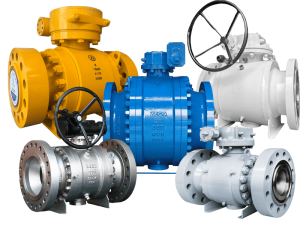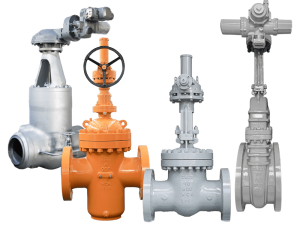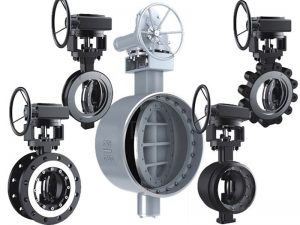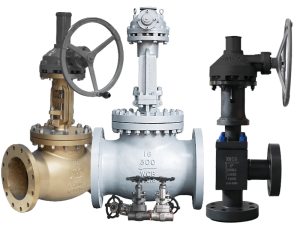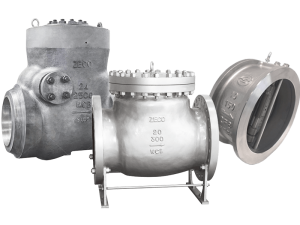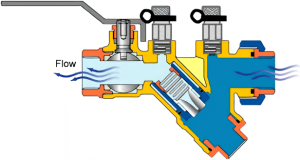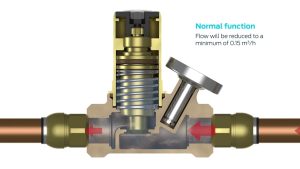Cuando se trata de seleccionar válvulas para aplicaciones industriales, dos opciones habituales son válvulas de compuerta y las válvulas de cuchilla. Ambas pueden utilizarse para controlar la entrada y salida de fluidos, pero presentan algunas diferencias clave que las hacen más adecuadas para determinadas aplicaciones. Entonces, ¿cómo decidir si una válvula de compuerta o de cuchilla es la más adecuada para su proceso?
Compararé estos dos tipos de válvulas de cierre para que pueda tomar una decisión informada en función de sus necesidades específicas. Veremos cómo funcionan, sus respectivos pros y contras y ejemplos de aplicaciones en las que cada válvula destaca.
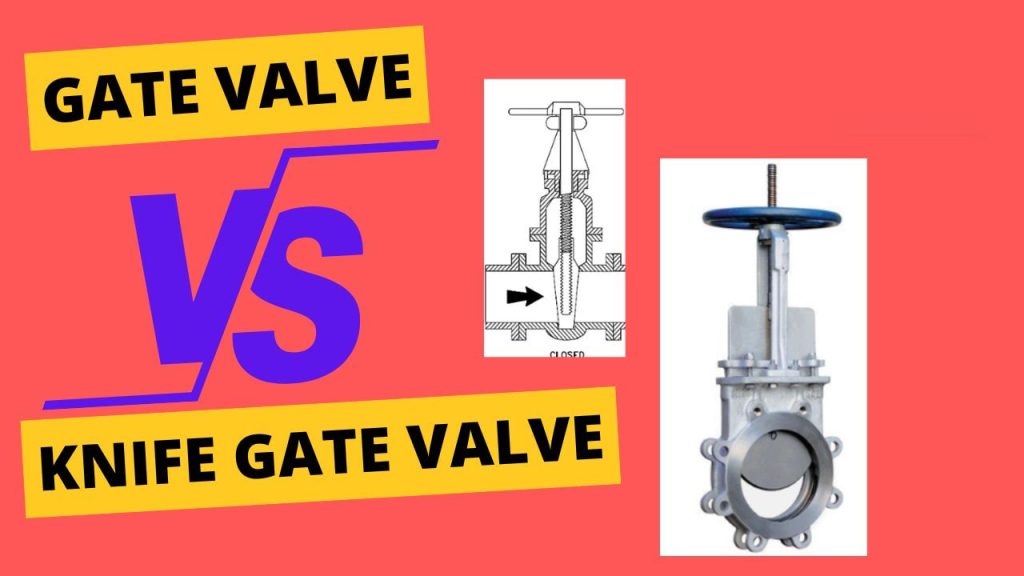
Índice
Funcionamiento de las válvulas de compuerta y de cuchilla
En primer lugar, veamos los fundamentos de cómo cada una de estas válvulas controla el flujo de fluidos.
Diseño y funcionamiento de las válvulas de compuerta
A válvula de compuerta consiste en un elemento de cierre plano (compuerta) que se desliza entre dos asientos paralelos para detener o permitir el flujo. La compuerta tiene una abertura igual al paso total del cuerpo de la válvula cuando está abierta.
Los diseños comunes de válvulas de compuerta incluyen:
- Compuerta en cuña: La compuerta tiene bordes en ángulo que se asientan contra asientos en ángulo coincidentes en una acción de cuña para crear un sello hermético.
- Compuerta de deslizamiento paralelo: La compuerta se desplaza entre asientos planos paralelos. Se utiliza sobre todo en aplicaciones de baja presión.
- Compuerta de cuña flexible: La compuerta está hecha de un material flexible que sella contra asientos metálicos. Puede manejar sólidos mejor que otras válvulas de compuerta.
Para abrir y cerrar una válvula de compuerta, hay que subir o bajar el vástago roscado para deslizar la compuerta hacia arriba o hacia abajo entre los asientos. Las válvulas de compuerta se utilizan principalmente como válvulas de apertura y cierre, más que para estrangular el caudal.
Diseño y funcionamiento de las válvulas de cuchilla
A válvula de cuchilla utiliza una compuerta metálica con un borde inferior afilado para cortar el fluido. Cuando se levanta la compuerta, la "cuchilla" de borde afilado se levanta del asiento y permite que el fluido fluya a través de todo el orificio.
La principal ventaja de una válvula de cuchilla es que el afilado borde inferior de la compuerta puede cortar sólidos, fibras o residuos que, de otro modo, podrían atascarse entre la compuerta y el asiento, impidiendo el cierre completo. Esto hace que las válvulas de cuchilla sean idóneas para fluidos como aguas residuales o lodos.
Para abrir y cerrar una válvula de cuchilla, el vástago roscado gira un cuarto de vuelta para subir o bajar la compuerta. Al igual que las válvulas de compuerta, las válvulas de cuchilla sirven principalmente como válvulas de apertura y cierre.
Comparación entre válvula de compuerta y válvula de cuchilla
Ahora que ya conoce los tipos básicos de válvulas, le presentamos una comparación detallada característica por característica:
Diseño del cuerpo de la válvula
- Las válvulas de compuerta suelen tener cuerpos más grandes y pesados que las válvulas de cuchilla. Suelen estar fabricadas con materiales como hierro fundido o acero y diseñadas para procesos industriales robustos.
- Las válvulas de cuchilla tienen cuerpos más delgados para adaptarse al diseño más afilado de la compuerta, lo que las hace mucho más ligeras. Los materiales habituales del cuerpo son hierro fundido, acero inoxidable o aluminio.
Presiones nominales
- Puede encontrar válvulas de compuerta en clases de presión que van desde 150 psi hasta 4500+ psi. Esto las hace adecuadas para una amplia variedad de aplicaciones industriales de presión.
- Las válvulas de cuchilla suelen tener presiones nominales más bajas que las válvulas de compuerta, en el rango de 100-500 psi. El diseño de la válvula de cuchilla limita la capacidad de alta presión.
Dirección del caudal
- La mayoría de las válvulas de compuerta son bidireccionales, lo que significa que el caudal puede pasar por la válvula en ambos sentidos.
- Las válvulas de cuchilla suelen ser unidireccionales, con flujo en una sola dirección. Esto coincide con el borde afilado del diseño de la compuerta.
Tallas disponibles
- Las válvulas de compuerta vienen en tamaños desde 1/2" hasta tuberías masivas de 72"+. Encontrará soluciones de válvulas de compuerta para todos los diámetros de tubería habituales.
- Las válvulas de cuchilla suelen tener tamaños de 2" a 48". Su nicho de uso implica que el dimensionamiento no se extiende a los tamaños de válvula de compuerta más grandes.
Estándares de la industria
- Las válvulas de compuerta se fabrican conforme a las normas ANSI o API que definen materiales, clases de presión, procedimientos de ensayo, etc. Esto las hace fiables e intercambiables.
- Las válvulas de cuchilla siguen normas patentadas que pueden variar según el fabricante. Es posible que tenga que adquirir las piezas de repuesto a su proveedor original.
Aplicaciones típicas
Ahora que ya conoce las principales diferencias en el diseño de las válvulas, ¿dónde se utilizan con más frecuencia las válvulas de compuerta y las de cuchilla?
Aplicaciones industriales de las válvulas de compuerta
Las válvulas de compuerta destacan en el control general de encendido/apagado en muchas industrias, entre las que se incluyen:
- Tratamiento de agua y aguas residuales.
- Oleoductos y gasoductos
- Plantas de transformación química
- Centrales eléctricas
- Instalaciones de fabricación
Básicamente, encontrará válvulas de compuerta en la mayoría de las plantas e instalaciones industriales que mueven fluidos a través de tuberías. Las válvulas de compuerta de hasta 12" o más de tamaño pueden accionarse manualmente, mientras que los actuadores automáticos suelen accionar tamaños mayores.
Aplicaciones industriales de las válvulas de cuchilla
Mientras que los nichos de aplicación de las válvulas de compuerta son amplios, las válvulas de cuchilla destacan en usos específicos como:
- Plantas de tratamiento de aguas residuales: Las válvulas de cuchilla manejan caudales cargados de sólidos con menos atascos.
- Plantas de pulpa y papel: El diseño de compuerta de cuchilla corta las fibras de pulpa para lograr un cierre positivo.
- Procesado de alimentos: Permite la manipulación de fluidos viscosos o con partículas.
- Minería: Controla los lodos minerales abrasivos y las tuberías de relaves.
- Producción de petróleo: Manipula petróleo crudo con alto contenido en sólidos.
Así pues, en procesos con fluidos fibrosos, fibrosos o llenos de residuos, una válvula de cuchilla suele ser la mejor opción frente a una válvula de compuerta.
Ventajas e inconvenientes de las válvulas de compuerta frente a las de cuchilla
Recapitulemos las diferencias características:
Profesionales de las válvulas de compuerta
- Amplios rangos de presión y temperatura
- Flujo bidireccional en la mayoría de los diseños
- Disponible en una amplia gama de tamaños más grandes
- Cumple las principales normas del sector
Válvula de compuerta Contras
- Más propensos a atascarse por restos en los fluidos
- Peso pesado en tallas grandes
Válvula de cuchilla Pros
- La puerta con filo de cuchillo atraviesa sólidos
- Diseño compacto y ligero
- Fácil de automatizar con actuadores
- Menor coste inicial que una válvula de compuerta
Válvula de cuchilla Contras
- La baja presión nominal limita las aplicaciones
- Flujo principalmente unidireccional
- Debe abastecerse de piezas de recambio patentadas
Elegir entre una válvula de cuchilla y una válvula de compuerta
Para elegir el tipo de válvula adecuado para su aplicación, tenga en cuenta:
- Presión y temperatura necesarias
- Presencia de sólidos, fibras o residuos en los fluidos
- Si el flujo es unidireccional o bidireccional
- Dimensiones disponibles de la válvula de tubería
- Limitaciones de costes
Comprender estas diferencias clave le ayudará a tomar la decisión óptima entre instalar una válvula de compuerta estándar o una válvula de cuchilla especializada. La asociación con un proveedor de válvulas experto le garantiza la elección de la tecnología de válvulas adecuada para sus fluidos de proceso y condiciones de funcionamiento específicos.

